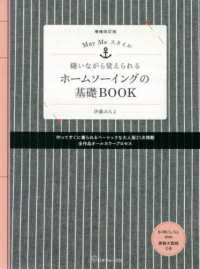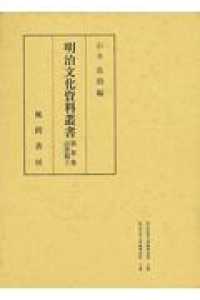- ホーム
- > 洋書
- > 英文書
- > Business / Economics
Full Description
This book provides a special interest theory of protection, developing a full general equilibrium theory that explains the distribution of income with goods markets, factor markets, lobbies, political parties, and voters all pursuing their self interest. This probabilistic voting model shows how well-organized groups can use seemingly irrational government policies to exploit poorly organized groups. Given rational predatory behaviour between these groups, protection or any other redistributive policy that improves the chances of election of a party increases political efficiency. This can create an economic black hole, conditions under which an entire economy can disappear into lobbying. Paradoxically, the tariff rates accompanying an economic black hole are very low. The economic waste is confined to lobbying costs. The book contains both theoretical and empirical work explaining protection in the United States (1900-88) and levels of protection in about sixty foreign countries in the 1980s.
Contents
Preface; Acknowledgments; list of results; 1. A preview of the results; 2. Endogenous policy theory: a diagrammatic approach; Part I. Endogenous Policy Theory with Specific Factors: The Theory of Industry Tariffs in Partial Equilibrium: 3. The probabilistic voting model of political efficiency and powerless politicians; 4. Endogenous lobbying theory and the contribution specialization theorem; 5. Endogenous tariff theory; 6. The power function model of endogenous industry lobbying; 7. Three simple tests of the Stolper-Samuelson theorem; 8. The invisible foot and the waste of nations: lawyers as negative externalities; Part II. Endogenous Policy Theory in General Equilibrium: A Long-Run Theory of National Tariff Levels: 9. The 2 x 2 x 2 x 2 model of endogenous redistribution theory; 10. A prisoner's dilemma theory of endogenous protection: the Leontief model; 11. The compensation effect and the multiple equilibrium trap; 12. increasing returns to politics and factor endowments: economic development and Brazilian vitality versus the Indian disease; 13. Endogenous protection in the United States, 1900-88; 14. A Cobb-Douglas model; 15. Black hole tariffs; 16. The endowment effect: cross-national evidence on endogenous tariffs; Part II. Postscript: 17. The senile-industry argument for protection; 18. Optimal obfuscation and the theory of the second worst: the politically efficient policy; Mathematical appendices; References; Author index; Subject index.








